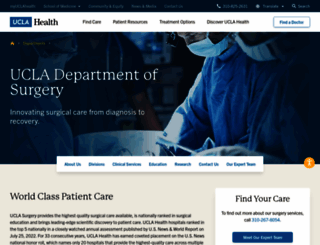UCLA Department of Surgery | UCLA Health
Page Load Speed
38.6 sec in total
First Response
295 ms
Resources Loaded
27.3 sec
Page Rendered
10.9 sec

About Website
Visit surgery.ucla.edu now to see the best up-to-date Surgery UCLA content for United States and also check out these interesting facts you probably never knew about surgery.ucla.edu
The UCLA Department of Surgery is committed to ongoing research in its quest to develop new treatments and cures, along with a commitment to educate and train the next generation of leading physicians...
Visit surgery.ucla.eduKey Findings
We analyzed Surgery.ucla.edu page load time and found that the first response time was 295 ms and then it took 38.3 sec to load all DOM resources and completely render a web page. This is a poor result, as 95% of websites can load faster.